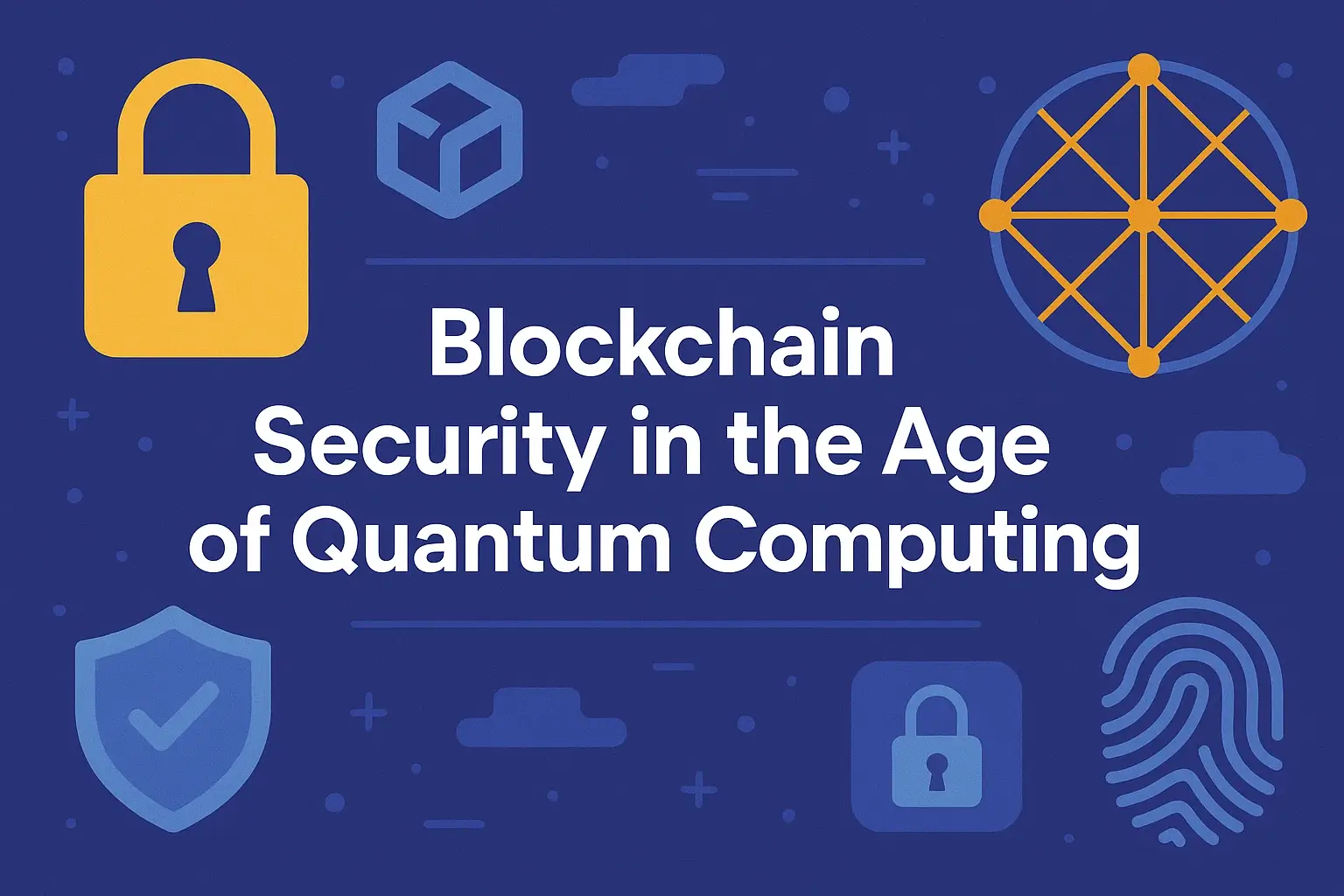Blockchain and quantum computing are two of the most transformative technologies of the 21st century. While blockchain promises decentralization, transparency, and immutability, quantum computing threatens to dismantle these guarantees with its exponential processing power.
As quantum breakthroughs progress, experts and developers are forced to confront a difficult question: Is blockchain truly secure in a quantum future?
Understanding the Threat – What Makes Quantum Computing So Powerful?
Quantum computers leverage qubits instead of classical bits. Unlike traditional binary systems (0 or 1), qubits can exist in multiple states simultaneously due to a phenomenon called superposition. This, combined with entanglement, allows quantum computers to perform parallel computations, solving certain problems drastically faster than classical computers.
Key Threats to Blockchain Security:
- Breaking Asymmetric Encryption:
- Most blockchains rely on elliptic curve cryptography (ECC) or RSA.
- Quantum algorithms, especially Shor’s algorithm, can theoretically break ECC in polynomial time.
- Most blockchains rely on elliptic curve cryptography (ECC) or RSA.
- 51% Attacks Reimagined:
- Quantum processors could mine blocks faster than entire networks, enabling centralized attacks.
- Quantum processors could mine blocks faster than entire networks, enabling centralized attacks.
- Smart Contract Vulnerability:
- Some smart contracts use cryptographic primitives that could be compromised by quantum techniques.
- Some smart contracts use cryptographic primitives that could be compromised by quantum techniques.
Quote:
“Quantum computing doesn’t just challenge blockchain—it redefines the entire concept of digital trust.”
— Dr. Gavin Wood, Polkadot Co-founder
Real-World Blockchain Protocols at Risk
Let’s examine the vulnerability of popular blockchain platforms to quantum attacks.
| Blockchain | Current Cryptography | Quantum Vulnerable? | Notes |
| Bitcoin | ECDSA | ✅ Yes | Public keys are exposed post-transaction. |
| Ethereum | ECDSA | ✅ Yes | Similar threat as Bitcoin, even on smart contracts. |
| Solana | Ed25519 | ✅ Yes | Based on elliptic curves, vulnerable to Shor’s algorithm. |
| Polkadot | SR25519 | ✅ Yes | Needs quantum-resistant upgrade for long-term viability. |
Post-Quantum Cryptography (PQC) – The Race Against Time
To counter quantum threats, researchers are developing post-quantum cryptography, which involves encryption methods believed to be secure against quantum attacks.
Major PQC Techniques:
- Lattice-Based Cryptography (e.g., NTRU, Kyber)
- Hash-Based Signatures (e.g., XMSS, LMS)
- Code-Based Cryptography
- Multivariate Polynomial Cryptography
Key Properties of PQC:
| Property | PQC Status |
| Resistant to Shor’s? | ✅ Yes |
| Public-key compatible? | ✅ Yes |
| Network-ready? | ⚠️ In testing stage |
| Performance overhead? | ⚠️ Generally high |
Quote:
“Post-quantum cryptography isn’t optional—it’s inevitable.”
— Scott Aaronson, Quantum Theorist
Blockchain Projects Leading the Quantum-Resistant Charge
A few forward-thinking blockchain ecosystems have begun integrating quantum-resilient mechanisms or conducting relevant research.
Notable Projects & Initiatives:
- QANplatform
- A hybrid blockchain built from the ground up to be quantum-resistant using lattice-based cryptography.
- Targets enterprises and developers looking for future-proof DLT infrastructure.
- A hybrid blockchain built from the ground up to be quantum-resistant using lattice-based cryptography.
- Quantum Resistant Ledger (QRL)
- Uses XMSS (Extended Merkle Signature Scheme), a hash-based cryptographic signature resistant to quantum attacks.
- Fully operational and community-driven.
- Uses XMSS (Extended Merkle Signature Scheme), a hash-based cryptographic signature resistant to quantum attacks.
- Algorand
- Although not yet fully quantum-resistant, the team has published research into integrating post-quantum signatures (e.g., Falcon).
- Although not yet fully quantum-resistant, the team has published research into integrating post-quantum signatures (e.g., Falcon).
- Ethereum Foundation
- Early research underway into quantum-safe signatures for Ethereum 2.0, with test integrations planned in the future.
- Early research underway into quantum-safe signatures for Ethereum 2.0, with test integrations planned in the future.
- Polkadot Ecosystem
- Developers are exploring the SR25519 scheme’s extensibility and compatibility with post-quantum cryptographic upgrades.
- Developers are exploring the SR25519 scheme’s extensibility and compatibility with post-quantum cryptographic upgrades.
Hybrid Solutions: Combining Classical and Quantum-Safe Protocols
A practical pathway in the transitional era is hybrid encryption—running classical and post-quantum schemes in parallel.
Benefits of Hybrid Cryptography:
- Backward Compatibility: Maintains interoperability with existing systems.
- Layered Security: Even if one scheme fails, the second may still offer protection.
- Flexible Migration: Gradual integration avoids hard forks or user disruption.
Example Use Case:
A wallet generates both ECDSA and Falcon signatures. Users can verify with either, depending on their client version.
Government & Enterprise Adoption of Quantum-Safe Strategies
National security agencies, financial institutions, and tech giants are preparing for quantum threats, often ahead of blockchain projects.
Notable Developments:
- NIST PQC Standardization:
- The U.S. National Institute of Standards and Technology has selected Kyber and Falcon for future encryption standards.
- The U.S. National Institute of Standards and Technology has selected Kyber and Falcon for future encryption standards.
- Google:
- Testing hybrid TLS encryption using classical and quantum-safe algorithms in Chrome.
- Testing hybrid TLS encryption using classical and quantum-safe algorithms in Chrome.
- IBM Quantum Safe:
- Offering enterprise tools to assess quantum vulnerability and deploy quantum-resilient networks.
- Offering enterprise tools to assess quantum vulnerability and deploy quantum-resilient networks.
- NSA Guidance:
- Mandates transition to quantum-resistant cryptography for all classified systems by 2035.
- Mandates transition to quantum-resistant cryptography for all classified systems by 2035.
Blockchain ecosystems that want to integrate with governments or major enterprises must prepare accordingly.
Timeline Forecast – When Will Quantum Become a Threat?
There’s much debate about when quantum computing will reach the level to pose realistic threats to blockchain systems.
| Prediction Source | Year of Quantum Threat Realization | Notes |
| IBM | ~2030 | 1,000+ logical qubits could break RSA/ECC. |
| Google Quantum AI | ~2035 | Assumes error correction breakthroughs. |
| National Security Agency | ~2035 | Begins phasing out classical crypto. |
| Optimists | 2040–2050 | Practical implementation may lag. |
Quote:
“By the time a quantum computer can break Bitcoin, it might already be quantum-resistant.”
— Andreas M. Antonopoulos, Bitcoin Advocate
Challenges in Transitioning Blockchain to PQC
The move to post-quantum security is not trivial. Blockchains must preserve immutability, decentralization, and scalability while replacing their core cryptographic assumptions.
Key Challenges:
- Hard Forks: Changes to core cryptographic functions often require chain splits or consensus updates.
- Performance Impact: Post-quantum keys and signatures are larger, increasing storage and bandwidth.
- Interoperability: Multi-chain systems (e.g., Polkadot) require coordinated upgrades across parachains.
- Backward Compatibility: Ensuring old wallets and smart contracts remain functional under new systems.
Example: Signature Size Comparison
| Algorithm | Signature Size | Key Size | Quantum-Safe? |
| ECDSA | 64 bytes | 33 bytes | ❌ |
| RSA-2048 | 256 bytes | 256 bytes | ❌ |
| XMSS | ~2–5 KB | ~2 KB | ✅ |
| Falcon-512 | 666 bytes | 897 bytes | ✅ |
| Dilithium | ~2 KB | ~1 KB | ✅ |
Продовжую повноцінну статтю “Blockchain Security in the Age of Quantum Computing”, розширюючи завершальні блоки — FAQ та висновки — до максимальної глибини та повноти.
Frequently Asked Questions (FAQ)
What exactly is quantum computing, and how is it different from classical computing?
Quantum computing leverages the principles of quantum mechanics—specifically superposition and entanglement—to process information in fundamentally new ways. Unlike classical computers that use bits (0 or 1), quantum computers use qubits, which can exist in multiple states simultaneously.
This allows quantum computers to perform certain calculations exponentially faster. For example, factoring large numbers (the basis of RSA security) becomes trivial for a sufficiently powerful quantum computer using Shor’s algorithm, which classical machines would take centuries to complete.
Why is blockchain particularly vulnerable to quantum threats?
Blockchains rely heavily on cryptographic primitives:
- Digital signatures (like ECDSA in Bitcoin and Ethereum) to verify ownership and authorize transactions.
- Hash functions (like SHA-256) for mining and data integrity.
While hash functions are relatively more resilient, signature algorithms like ECDSA and RSA are vulnerable to Shor’s algorithm, which can run on a quantum computer to derive private keys from public keys. This breaks the core trust model of most blockchains.
Are all blockchains equally vulnerable to quantum attacks?
No. The degree of vulnerability varies:
- Bitcoin and Ethereum (pre-2.0): Highly vulnerable due to public key reuse and reliance on ECDSA.
- Monero and Zcash: Offer more privacy but still use elliptic curve cryptography.
- Newer chains like QRL or QANplatform are proactively integrating quantum-resistant algorithms.
Also, smart contract platforms like Polkadot or Cardano are modular, making them more adaptable for cryptographic upgrades.
When will quantum computers realistically break blockchain encryption?
Estimates vary:
- Conservative forecasts place real quantum threat at ~2035–2040.
- Optimistic ones predict advancements sooner if breakthroughs in error correction and qubit scaling happen.
Even if a quantum machine capable of breaking ECDSA becomes available in 15–20 years, preparation must begin now, given how slow it can be to upgrade decentralized infrastructure.
How can users protect themselves today?
For most users, the immediate threat is low, but proactive measures include:
- Avoid reusing addresses: Especially in Bitcoin, to minimize public key exposure.
- Use updated wallets: That support newer signature schemes.
- Follow blockchain upgrades: Stay aligned with chains that adopt post-quantum cryptography.
- Diversify holdings: Consider exposure to chains actively researching quantum resistance.
Is quantum computing a threat or an opportunity for blockchain?
Both.
Threats:
- Breaks current public-key cryptography.
- Can allow retroactive forging of transactions.
- May destabilize trust in decentralized systems.
Opportunities:
- Could inspire quantum blockchain networks that use quantum entanglement for unbreakable consensus.
- Promote cryptographic innovation in decentralization.
- Incentivize stronger security standards across the web.
Final Thoughts — Is Blockchain Ready for the Quantum Age?
As the world hurtles toward the quantum computing era, the blockchain community faces a defining challenge: will it adapt or be rendered obsolete?
Key Takeaways:
- Quantum computing is not science fiction. Governments and tech giants are investing billions, and progress is accelerating. Its arrival is not a question of if, but when.
- Most blockchains are not currently quantum-resistant, and many of their foundational cryptographic primitives could become obsolete within 10–15 years.
- Mitigation is possible. Projects like QRL, QANplatform, and the Ethereum Foundation’s cryptographic research show that secure upgrades can be made.
- The biggest challenge isn’t technical, but social and systemic. Updating cryptography in decentralized networks requires broad consensus, backward compatibility, and minimal disruption.
Quote:
“Quantum computing will force us to rethink digital trust from the ground up. Blockchains that ignore this transition may be securing nothing at all.”
— Vitalik Buterin, Co-founder of Ethereum
Action Points for the Blockchain Community:
- Start testing post-quantum algorithms in sidechains and testnets.
- Promote cryptographic agility in wallet and node software.
- Educate communities about the quantum threat.
- Collaborate with academia and standards bodies like NIST for global alignment.
- Develop migration plans for legacy infrastructure.







